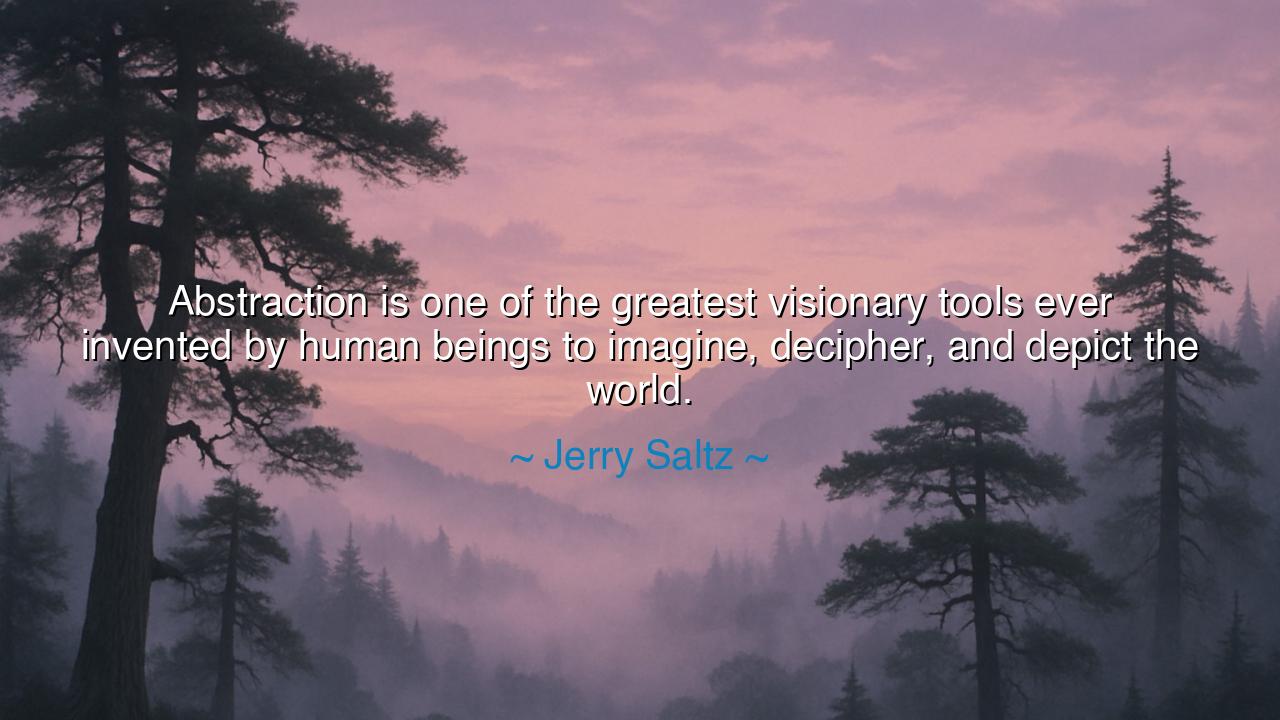
Abstraction is one of the greatest visionary tools ever invented
Abstraction is one of the greatest visionary tools ever invented by human beings to imagine, decipher, and depict the world.






"Abstraction is one of the greatest visionary tools ever invented by human beings to imagine, decipher, and depict the world." Thus spoke Jerry Saltz, the critic and philosopher of art, whose words remind us that the act of abstraction—so often misunderstood—is nothing less than a mirror of the divine impulse to create. In these few lines, he unveils a truth that reaches beyond the gallery walls and into the soul of all human imagination: that abstraction is not an escape from reality, but a way to see it more deeply, to distill the chaos of existence into patterns of meaning and light. For to abstract is to seek essence—to remove the clutter of the visible so that we might glimpse the invisible.
In the beginning, long before language or writing, man painted on the walls of caves. There, in the flicker of firelight, the first artists reduced the world to symbol—a handprint, a line, a beast in motion. These early acts of abstraction were not decoration; they were attempts to grasp the mystery of life itself. The hunters who painted the bison were not copying what they saw, but translating it into meaning—transforming raw experience into vision. Thus, from the dawn of time, abstraction has been the tool by which humankind has imagined the world anew. It is not the enemy of realism, but its foundation—the sacred fire that burns beneath the surface of all art, all science, all thought.
Saltz, speaking as one who has walked among the works of Kandinsky, Rothko, Pollock, and countless others, understood that abstraction is not confined to canvas. It is a visionary instrument of perception itself. To abstract is to see beyond form—to look upon a river and perceive not merely water, but motion, reflection, eternity. It is to look upon human struggle and see not tragedy alone, but the pulse of universal longing. The abstract artist, like the philosopher or the mathematician, strips away the visible to reveal the eternal law that hides beneath. The mathematician’s symbols and the painter’s colors are brothers; both are languages of essence.
Consider the story of Wassily Kandinsky, the man who first dared to paint without figures, without landscapes—only the music of color and line. His contemporaries mocked him, calling his work chaos. Yet Kandinsky was not painting confusion; he was painting the invisible harmony he heard within the world. He believed that color had its own sound, that form had its own emotion, and that art should awaken the spirit as music awakens the soul. Through his daring, abstraction was born—not as decoration, but as revelation. He dared to see reality not as the eye perceives it, but as the heart feels it.
But this truth extends far beyond art. The scientist, too, is an abstract thinker. When Newton saw the apple fall, he did not merely see fruit and gravity—he abstracted the act into law. When Einstein looked at the universe, he imagined space bending upon itself, time flowing like a river. These are acts of abstraction—the highest kind of vision, where the mind moves beyond what is seen into what is understood. Saltz’s words remind us that abstraction is the common thread between the artist, the thinker, and the dreamer. It is the lens of imagination, the bridge between reality and possibility.
Yet there is humility in this art. To abstract is to admit that the world cannot be captured in its fullness. It is to bow before mystery while still daring to touch it. The abstract thinker accepts that truth cannot be held in the hand, only traced in patterns, symbols, and dreams. This is why abstraction feels both universal and deeply personal—because it is the language of the soul, spoken in forms that defy the limits of the tangible. When we engage with abstraction—whether in art, in thought, or in emotion—we are reminded that reality is deeper than appearance, that life is not merely what we see, but what we imagine it to be.
So, my children of vision and wonder, take this teaching to heart: learn to see beyond the surface. Whether you paint, speak, build, or love, remember that abstraction is your birthright. Look at the world not as it appears, but as it might be when filtered through the light of your own soul. Let your imagination strip away the noise of detail until only truth remains. For when you dare to think abstractly, you are not escaping reality—you are creating it anew.
And remember always the wisdom of Jerry Saltz: "Abstraction is one of the greatest visionary tools ever invented by human beings to imagine, decipher, and depict the world." To imagine is to create; to decipher is to understand; to depict is to make the invisible visible. Through abstraction, you join the lineage of all creators—from the cave painter to the poet, from the philosopher to the physicist. It is not the distance from reality, but the doorway into its heart. Embrace it, and you will see the world not as it is—but as it eternally strives to become.






AAdministratorAdministrator
Welcome, honored guests. Please leave a comment, we will respond soon